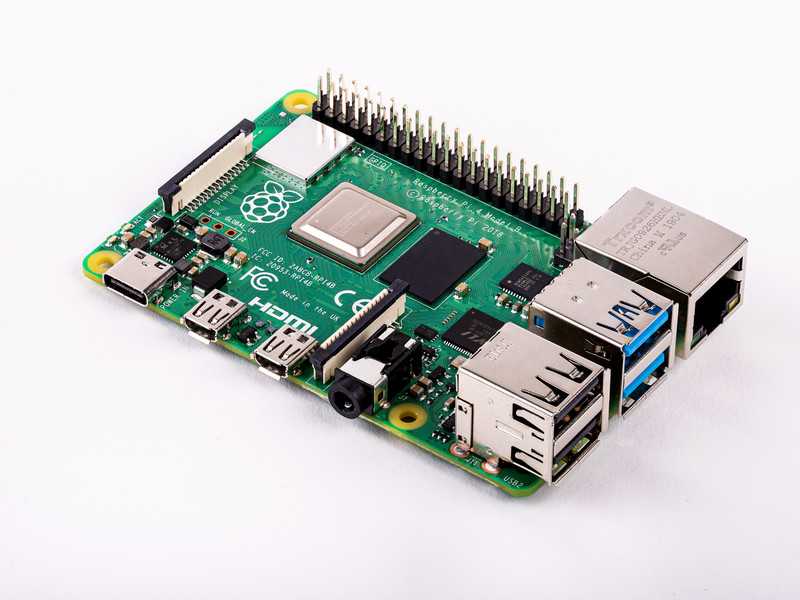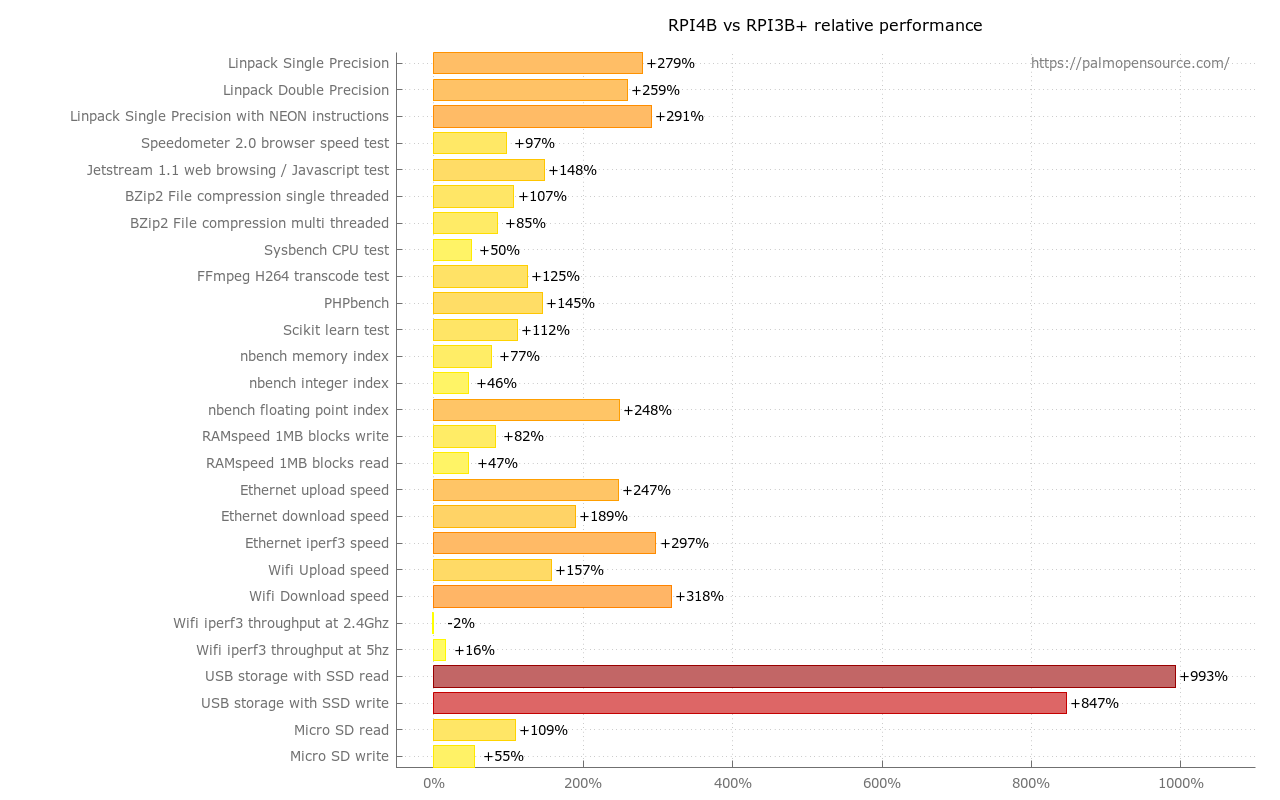As you may know our beloved Raspberry PI got a nice upgrade with the PI 4B! You will see in the benchmarks below that our Raspi has really improved on all aspects...
So is it worth the upgrade? I compiled the benchmark results I have found around the Net and I'll summarise the performance increase by comparing it to the PI3 model B+ performance, using percentages to make the comparison of the two Raspberrys even easier.

Raspberry PI 4 specs versus PI 3 B+
Here are some of the key improvements:
- Processor: The Pi 4 features a 1.5 GHz (or 1.8 GHz with latest boards) quad-core ARM Cortex-A72 processor, which is a significant upgrade over the 1.4 GHz quad-core ARM Cortex-A53 processor found in the Raspberry Pi 3. This processor provides up to three times the performance of the previous generation.
- GPU: The Raspberry Pi 4 GPU specs show a Videocore 6 microarchitecture clocked at 500 Mhz, vs a 300 Mhz Videocore 4 on the Pi 3
- RAM: The Pi 4 is available with up to 8 GB of LPDDR4 SDRAM, which is a significant improvement over the 1 GB or 2 GB of RAM found in earlier models. This means the Pi 4 can handle more memory-intensive tasks and can support multiple applications running at the same time.
- USB Ports: The Pi 4 features two USB 3.0 ports, which provide faster data transfer rates than the USB 2.0 ports found on previous models. There are also two USB 2.0 ports for compatibility with older peripherals.
- Video Output: The Pi 4 can support up to two 4K displays via its two micro-HDMI ports, or a single display at up to 60 frames per second. A significant improvement over the single HDMI port found on previous models.
- Wireless connectivity: The Raspberry Pi 4 features built-in dual-band 802.11ac wireless networking. It also has Bluetooth 5.0 support, which allows for better range and speed than previous versions.
Raspberry PI 4 CPU Performance comparison
The PI4 CPU upgrade to a quad core Cortex-A72 (BCM2711) gives an impressive boost as confirmed in benchmarks given by Brian Benchoff , MagPI and Avram Piltch. Below is the increase in percent over the previous generation Raspberry PI3B+:
- Linpack Single Precision: +279%
- Linpack Double Precision: +259%
- Linpack Single Precision with NEON instructions: +291%
- Speedometer 2.0 browser speed test: +97%
- Jetstream 1.1 web browsing / Javascript test: +148%
- BZip2 File compression single threaded: +107%
- BZip2 File compression multi threaded: +85%
- Sysbench CPU test: +50%
- FFmpeg H264 transcode test: +125%
- PHPbench: +145%
- Scikit learn test: +112%
- PassMark CPU mark: +91% (819 vs 428)
- nbench memory index: +77%
- nbench integer index: +46%
- nbench floating point index: +248%
So it seems that new CPU is a lot better on floating point operation.
I've run nbench on a 1800Mhz PI 4B, and here are the raw results with a 32 bits GCC-12 compilation plus -O2 optimisation:
TEST : Iterations/sec. : Old Index : New Index
: : Pentium 90* : AMD K6/233*
--------------------:------------------:-------------:------------
NUMERIC SORT : 697.01 : 17.88 : 5.87
STRING SORT : 162.62 : 72.66 : 11.25
BITFIELD : 2.5387e+08 : 43.55 : 9.10
FP EMULATION : 194.95 : 93.54 : 21.59
FOURIER : 42707 : 48.57 : 27.28
ASSIGNMENT : 24.144 : 91.87 : 23.83
IDEA : 5143.7 : 78.67 : 23.36
HUFFMAN : 1983 : 54.99 : 17.56
NEURAL NET : 38.672 : 62.12 : 26.13
LU DECOMPOSITION : 1166.4 : 60.42 : 43.63
==========================ORIGINAL BYTEMARK RESULTS==========================
INTEGER INDEX : 57.597
FLOATING-POINT INDEX: 56.701
Baseline (MSDOS*) : Pentium* 90, 256 KB L2-cache, Watcom* compiler 10.0
==============================LINUX DATA BELOW===============================
CPU : 4 CPU 1800MHz
L2 Cache :
OS : Linux 6.6.31+rpt-rpi-v8
C compiler : gcc version 12.2.0 (Raspbian 12.2.0-14+rpi1)
libc : /lib/arm-linux-gnueabihf/libc.so.6
MEMORY INDEX : 13.459
INTEGER INDEX : 15.099
FLOATING-POINT INDEX: 31.449
Baseline (LINUX) : AMD K6/233*, 512 KB L2-cache, gcc 2.7.2.3, libc-5.4.38
For the record, results on my PI3B+ are, and it confirms the huge improvements on the floating-point side:
MEMORY INDEX : 7.596
INTEGER INDEX : 10.285
FLOATING-POINT INDEX: 9.013
If you're interested in Machine Learning you'll also find that the new PI 4 model B with a Coral USB gives better results in image recognition, than the Coral Dev board.

Raspberry PI 4 memory bandwidth
Thanks to the move from LPDDR2 to LPDDR4 2400, the theoretical available RAM bandwidth has increased threefold. Brian Benchoff confirmed a large improvement in RAM bandwidth, nearly twice on RAM writes:
- RAMspeed 1MB blocks write: +82%
- RAMspeed 1MB blocks read: +47%
- Passmark 10 Memory mark: ? (? vs 72.3)
Raspberry PI 4 Networking improvements
Here Brian Benchoff, and Avram Piltch, show the benefits of the new Gigabit Ethernet chip.
- Ethernet upload speed: +247%
- Ethernet download speed: +189%
- Ethernet iperf3 speed: +297%
- Wifi Upload speed: +157%
- Wifi Download speed: +318%
- Wifi iperf3 throughput at 2.4Ghz: -2%
- Wifi iperf3 throughput at 5hz: +16%
You'll note some contradictions in the Wifi numbers above. I think that the test conditions were not the same in upload/download tests, and that the iperf3 numbers are the right ones.
Latest RPI 4B boards are now clocked at 1.8 Ghz by default, giving another 20% boost.
Raspberry PI 4 USB and MicroSD card storage
Thanks to the USB3 ports, it is now possible to use the PI4 as a small NAS server with a tenfold performance increase, as noted by Brian Benchoff
- USB storage with SSD read: +993%
- USB storage with SSD write: +847%
Gareth Halfacree also benchmarked the MicroSD port with a 64GB Samsung Evo Plus microSD XC, and found a nice improvement over the old Raspberry PI3B+:
- Micro SD read: +109%
- Micro SD write: +55%
Raspberry PI 4 power consumption
The power consumption of the Raspberry Pi 4 is higher than previous models due to its more powerful processor and increased RAM. However, the Pi 4 has a new power management chip that can control the power usage of the USB ports, and the Ethernet port now supports low-power mode (IEEE 802.3az).
- CPU Idle: 2.7 watts (vs 1.9 watts on the PI 3B+)
- CPU Loaded: 6.4 watts (vs 5.1 watts)
That's between 25 and 42% more than the PI 3B+, but with twice the speed in many areas, so depending on the load, a PI4 may consume less power at the end of the day.
Conclusion
So yes, the new PI4 performance/price ratio is on top, outperforming the PI3B+ and many other clones. I will surely use it in my new Domoticz installation!
To support the blog you can buy your next Raspberry PI using this link:



Speak your mind: